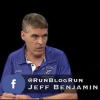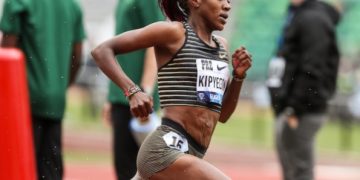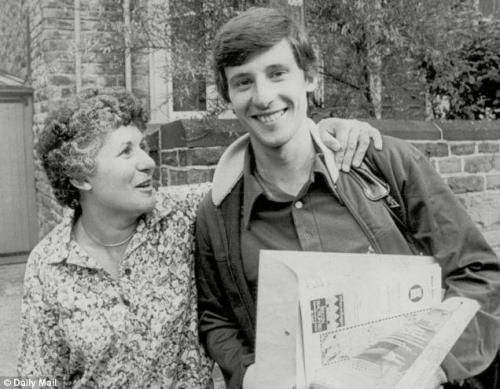 Mother Angela with Seb Coe, photo copyright The Daily Mail UK
Mother Angela with Seb Coe, photo copyright The Daily Mail UK
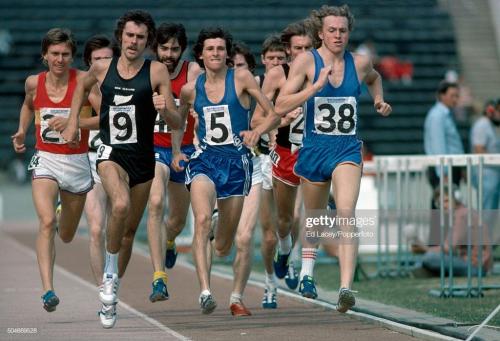 Dave Morecroft (2-), Rod Dixon (9), Frank Clement, Seb Coe (5), the 1976 AAA Champs, photo by Getty Images / British Athletics
Dave Morecroft (2-), Rod Dixon (9), Frank Clement, Seb Coe (5), the 1976 AAA Champs, photo by Getty Images / British Athletics
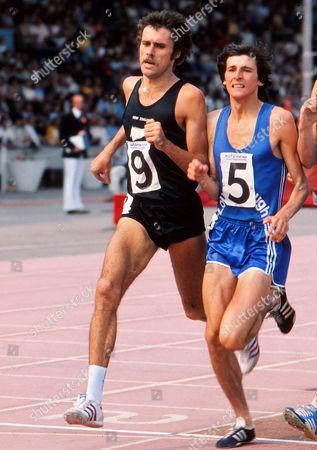 Rod Dixon, Seb Coe, the 1976 AAA Champs, photo by Shutterstock, copyright with Shutterstock
Rod Dixon, Seb Coe, the 1976 AAA Champs, photo by Shutterstock, copyright with Shutterstock
This is part 1 of the three part series by Jeff Benjamin on the 40th anniversary of Seb Coe’s 41 Days in 1979. This piece is on the 800m World Record. I recall the 800m record making the National news back in 1979. This piece brings back memories.
The 40th Anniversary of Seb Coe’s 41 Days In 1979 – Part 1 of 3 – The 800 Meters World Record
July 5, 1979 didn’t get off to a great start in the Coe family household. With father Peter working and their son Sebastian competing over in Oslo in his first experiences on the famous track racing circuit, mother Angela Coe had to deal with her daughter Emma.
“My sister hadn’t had the greatest school report,” recalled Coe recently as his late mother no doubt was naturally stressed out to say the least. “But by 7:30 that evening,” said Seb, “that focused totally altered.”
“Altered” was an understatement.
Racing on the famed Oslo Bislett stadium track, Coe shocked the Sports world as the 22 year old University student shattered the 800 meters world record, running 1 minute, 42.33 seconds, knocking more than a second off of the previous world record of Cuban Olympic star Alberto Juantorena.
“We heard his name on the television but we really had no idea what he (Seb) did because we began shouting and screaming,” said Angela Coe in the film “Sebastian Coe – Born To Run”. Mrs. Coe had to phone a local newspaper headquarters to find out exactly what her son had accomplished.
As for Seb’s sister Emma and her bad day at school? “There were 2 beneficiaries in the family that night -Emma and me!”, said Coe. “She said that it was a blessing from heaven.”
And it was only the beginning, as Coe would go on to electrify the sports world over a period of 41 days, beginning with his 800 meter world record and then on to breaking the Mile and 1500 records as well.
Seeds of Greatness
Many Track & Field aficionados and fans are well aware that Sebastian Coe, the current world leader of the IAAF who also successfully orchestrated the 2012 London Olympic Games, was coached in a very high quality training program created and utilized by his father Peter who, along with strength coach George Gandy, used ideas that were
at the time viewed as unorthodox in the ways of middle-distance training. Combining speed training, hill running along with agonizing intervals and weight training Coe would develop gradually over a decade and was already shown flashes of greatness during his buildup years as well.
“In 1976 when I won the AAA 1500, Seb was quite young but he looked like a future star,” said New Zealand Olympic Bronze medalist Rod Dixon. “I warned others that one day he might go all-out in a race and NOT come back!”
At that same year’s Rediffusion Games 1-Miler held in Gateshead, Coe tried to put that strategy to good use against British star Dave Moorcroft and Olympic Champion/ 1-Mile World Record Holder John Walker. “I had about 40 yards on those guys,” said Coe of his aggressive tactics. “Walker thought I was rabbiting or I’d collapse, but Moorcroft said to him, “You know that kid’s not coming back!” Moorcroft and Walker would eventually and dramatically catch the 19 year old Coe. “I was quite happy to finish 3rd,” said Coe, proving to himself that as he progressed, he could compete at their level.
The last 250 of that 1976 race below –
https://m.youtube.com/watch?v=Yv7TOHglDXs
Racing sporadically and pursuing University studies, as well as combating a few injuries which all runners experience, Peter Coe made sure to train his son to be ready during key times of the racing season.
In 1978, Coe would once again push it, as he ran a 49 second first lap at the European Championships in Prague, before being overtaken in the final straight by British compatriot Steve Ovett, who was then overtaken by East Germany’s Olaf Beyer.
The race below –
“It seemed to me that as time went on, Seb going all-out in his races might have looked crazy but he wasn’t dying out anymore,” said Dixon. “He was finishing quite strongly and hanging on and he was still quite young.”
The 800 Meters
Although competing at a high level, Coe’s 1979 European track tour was the first real time that he’d become immersed in the circuit. “I was a rookie and I pretty much believed that I wasn’t in their league,” said Coe of the legendary runners he’d now get to hang around with and get to know more intimately than before. “It was the best education I had,” said Coe of getting to know especially the Kiwi trio of Walker, Dixon and Dick Quax better than before. “In a way they were like my idols.” for a kid like myself who’d just left the University it was just phenomenal!”
“I recall one of the days before the meet Seb joined John Walker and I for a run,” said Dixon, who went on to describe the differences in training. “John and I were going out for 40 minutes and then we’d turn around and Seb went with us for around 15 minutes or so before he turned around because that was his plan,” recalled Dixon. “He didn’t deviate from his training.”
“I was doing some faster work as well,” said Coe, who also believes the inspirational experiences with Dixon and the Kiwis affected him as well. “For a kid like myself who’d just left the University being around those guys was just phenomenal!”
The day before, Coe did an afternoon run with a series of “warm-up 150 meters.” Watching and timing this session were Marathon Legend Grete Waitz and her husband/Coach Jack, who told Coe that he was “Going well.”
According to David Miller’s book, “Sebastian Coe Born To Run”, :
“I felt I should report the session and back home Peter said, “Go out and have a go. Run the first lap in 50/50.5, then hang on and see what happens.” My own feeling was that if the wind died when the sun went down the next day, I might get somewhere near the European record of 1:43.7″ Peter Coe also felt that perhaps Seb could try for Juantorena’s world record of 1:43.50 by the end of the season.
Peter Coe’s designs were off by 2 months!
Led by pacemaker Lennie Smith, Coe followed right behind him with Mike Boit in the fray. After a
sub 25-second 200 and a 50.5 first lap, Coe was all alone. Spectating from lane 8, Rod Dixon looked at his watch. ” I wondered if this was going to be the day I talked about.”
Maintaining his rhythm (“He looked like he could have run 1:40, he never tied up at all,” said Walker) Coe crossed the line to an astonished crowd. “I had no idea what I had run,” said Coe. “I had my hands on my knees and it was Rod who thrust a watch into my face and said, “You just ran 1:42!!!”
With the announcement to the crowd of the new world record at 800 meters, the crowd and Coe both exploded in jubilation. “I had no idea I ran that quickly,” said Coe.
The Race Below –
And it was only the beginning of the Avalanche.
Next Up – Part 2 – The Dream Mile!
Jeff Benjamin has written for 30 years for American Track and Field along with RunBlogRun. The Former President of the Staten Island AC & Chair of the Staten Island Running Association was the 5th man scorer for his Susan Wagner High School NYC XC City Championship team. Also a member of the College of Staten Island Sports Hall of Fame for XC, Jeff currently serves as the LDR Chairman for USATF NY. A passionate (or fanatical) follower of the Sport, some of Jeff's subjects have included Sebastian Coe, Emma Coburn, Eamonn Coghlan, Matt Centrowitz, Jim Spivey, Galen Rupp, Joe Newton, Tom Fleming, Ajee’ Wilson, Bill Rodgers, Allan Webb, Abel Kiviat, Jordan Hassay, Marty Liquori, Caster Semenya, Rod Dixon, Carl Lewis and Jim Ryun as well as Book Reviews and articles covering meets and races in the Northeast U.S.
View all posts
 Mother Angela with Seb Coe, photo copyright The Daily Mail UK
Mother Angela with Seb Coe, photo copyright The Daily Mail UK Dave Morecroft (2-), Rod Dixon (9), Frank Clement, Seb Coe (5), the 1976 AAA Champs, photo by Getty Images / British Athletics
Dave Morecroft (2-), Rod Dixon (9), Frank Clement, Seb Coe (5), the 1976 AAA Champs, photo by Getty Images / British Athletics  Rod Dixon, Seb Coe, the 1976 AAA Champs, photo by Shutterstock, copyright with Shutterstock
Rod Dixon, Seb Coe, the 1976 AAA Champs, photo by Shutterstock, copyright with Shutterstock